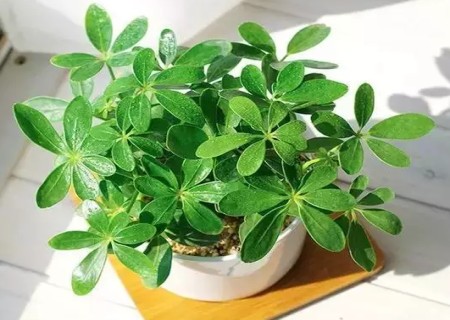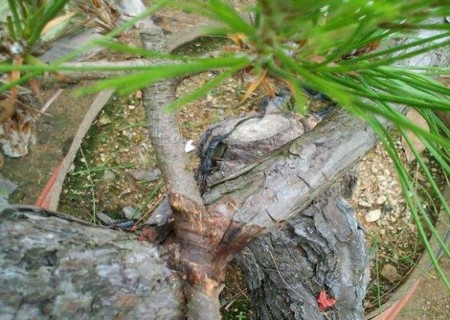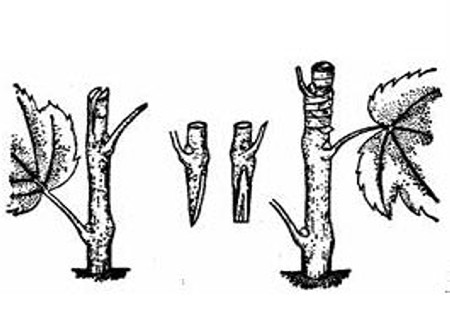A diagram of cutting method of aromatherapy
Duck foot wood is a wealth tree in China, many public places, and even the courtyard foyer are placed a pot of duck foot wood, very stylish. Duck foot wood not only plays a good role in beautifying and greening the household environment, but also plays a role in fengshui, duck foot wood has a certain role in avoiding evil spirits. There is a saying is like this: the leaves are relatively wide, the leaf area is relatively large potted plants are good to ward off evil spirits, and the duck foot wood is good in places with evil spirits. If you already have a pot of duck foot wood at home, you might as well try how to cut out more pots!

In late June, select the middle and lower part of the semi-lignified branch of the raw duck palm wood, cut a cuttage of about 10 cm, leave 2 leaves at the top, cut off 1 blade and 2 leaflets, and take root 40-60 days after insertion. Then the strong seedlings with well-developed roots were planted in the pot at the end of autumn or before germination in spring. Before planting, the tile is padded with a water seepage hole at the bottom of the container, and part of the nutritious soil is filled in the container, and then the soil is filled so that the root is closely connected with the soil, and the soil surface is flat with the edge of the basin. After pouring water and settling, the soil surface is about 5 cm away from the edge of the basin as a watering nozzle. The new plants should be placed in the semi-shade for a week, and then gradually transferred to a sunny place for normal management.
Domestic reproduction of goose palm wood substrate propagation, rapid propagation. The cutting time should be in the late spring and early summer, generally at room temperature: 15 ℃ at night and 25 ℃ in the day, which is the most suitable growth temperature after cutting.
From the mother plant that has been growing for several years, cut the annual branches 6cm to 8cm, or combine with changing pots, re-cutting in spring, and cutting the branches as cutting materials. Remove the inserted leaves and cut them in a plastic flowerpot with a diameter of 15cm to 20cm in a pre-soaked perlite, with a tray at the bottom to receive the exudate. 3 plants or individual plants in each pot can take root about one and a half months after cutting, and should be kept moist with regular irrigation after cutting. Put it in the indoor weak light place after insertion, strengthen the fertilizer and water management, pour the nutrient solution after taking root, and replenish the liquid once a week in the basin, 100ml each time.
The specific operation methods / steps are as follows:
1. Cutting time
The cutting time of duck foot wood must avoid high temperature in summer and low temperature in winter, and it is the best in early spring and early autumn, the temperature is not high and happens to be in the growing season of duck foot wood, so it is not easy to rot roots, which is very beneficial to cutting rooting.
2. Branch selection
The cuttage branch of duck foot wood is not suitable to choose the same year branch, had better choose more than 2 years old branch, select its robust 15-20 cm branch to cut off, but do not affect the ornamental ability of the original plant, remove the bottom leaf, retain the top 3 leaves or so.
3. Branch treatment
After selecting the branch, the knife edge of the branch needs to be disinfected, the prepared alcohol is smeared on the knife edge, then dried, and the branch is immersed in an aqueous solution with rooting powder for 4-6 hours, waiting for cutting.
4. Soil culture cutting
Duck foot wood soil cuttage preparation materials: flowerpot, soil, water
1) cut the sturdy and full branches, take the branches with terminal buds, 3-5 nodes and 9-15 cm long as cuttings, the first-2 pairs of leaves below them can be removed, and the leaves are partially cut off to facilitate cutting.
2) after taking the terminal bud cuttings, the lower branches or mature branches can be taken with 3-5 nodes or 10-15 cm long branches as cuttings. Keeping several leaves as far as possible is beneficial to improve the survival rate of cuttings.
3) it takes 2-3 weeks to have the root, which is transplanted in a large basin or field.
4) cushion the bottom of the flowerpot with stone or other hard objects at the outlet of the basin, cover the bottom with a thin layer of sand, and then pour into the prepared soil. Slowly insert the cut branches into the soil, compact the soil, and then pour water through it.
5) after pouring through the water, put it in a place with suitable temperature, and when the soil is a little dry, water it in time. To keep watering timely, the temperature is suitable, usually a month will send out new leaves, which proves that the cuttage is successful. After sending out new buds, you can continue to keep them in this basin and change them next year.
5. Hydroponic cuttage
1) the branches soaked in rooting powder are cut in a glass container containing water, and the amount of water reaches 3/4 of the container. In the first two weeks, the fresh water should be changed every day, and the hydroponic nutrient solution should be added and placed in the bright place of the room. The hydroponic duck foot wood needs to keep the temperature above 15 ℃ at the initial stage, and white calli begin to form at the cut of the branches that are usually immersed in water for about 10 days. It soon differentiated from these places to form adventitious roots.
2) after about 45 days, the branches of duck feet planted in water will produce roots of more than 6cm meters and grow white root hairs, which can be managed normally. After the root system grows, the water can be changed every 3-5 days. After that, you can choose to continue aquaculture or transplant it into a flowerpot.
Note:
1. If the duck foot wood is obtained by cutting, do not rush to change the basin in order to form, wait for the obvious growth to change the basin. Usually grow 2-3 grandma to change the basin, and then change the basin once a year.
2. Create a comfortable maintenance environment. Ensure that the temperature is suitable, drought and waterlogging are suitable, watering is timely, and spraying water to the leaf surface in summer is timely to ensure sufficient light time.
Time: 2019-06-09 Click:
- Prev

Grafting method of mountain pine potted landscape
Grafting can improve the quality and improve the ornamental effect, so grafting is often used in bonsai creation. Due to the strong germination of green wood, the first cut down the mountain is often to cut off the high trunk, use the ideal lateral branches of the pile foundation to cultivate the new trunk, dwarf, and concentrate it into the scene in the pot. but
- Next

Grafting technique of Twig of Pear Tree
Grafting is the propagation of branches or buds from one plant to the branches, stems or roots of another plant to form a new plant. The seedlings cultivated by grafting are called grafted seedlings. The branch or bud used for grafting is called scion, and the plant that bears scion is called rootstock.
Related
- Fuxing push coffee new agricultural production and marketing class: lack of small-scale processing plants
- Jujube rice field leisure farm deep ploughing Yilan for five years to create a space for organic food and play
- Nongyu Farm-A trial of organic papaya for brave women with advanced technology
- Four points for attention in the prevention and control of diseases and insect pests of edible fungi
- How to add nutrient solution to Edible Fungi
- Is there any good way to control edible fungus mites?
- Open Inoculation Technology of Edible Fungi
- Is there any clever way to use fertilizer for edible fungus in winter?
- What agents are used to kill the pathogens of edible fungi in the mushroom shed?
- Rapid drying of Edible Fungi

